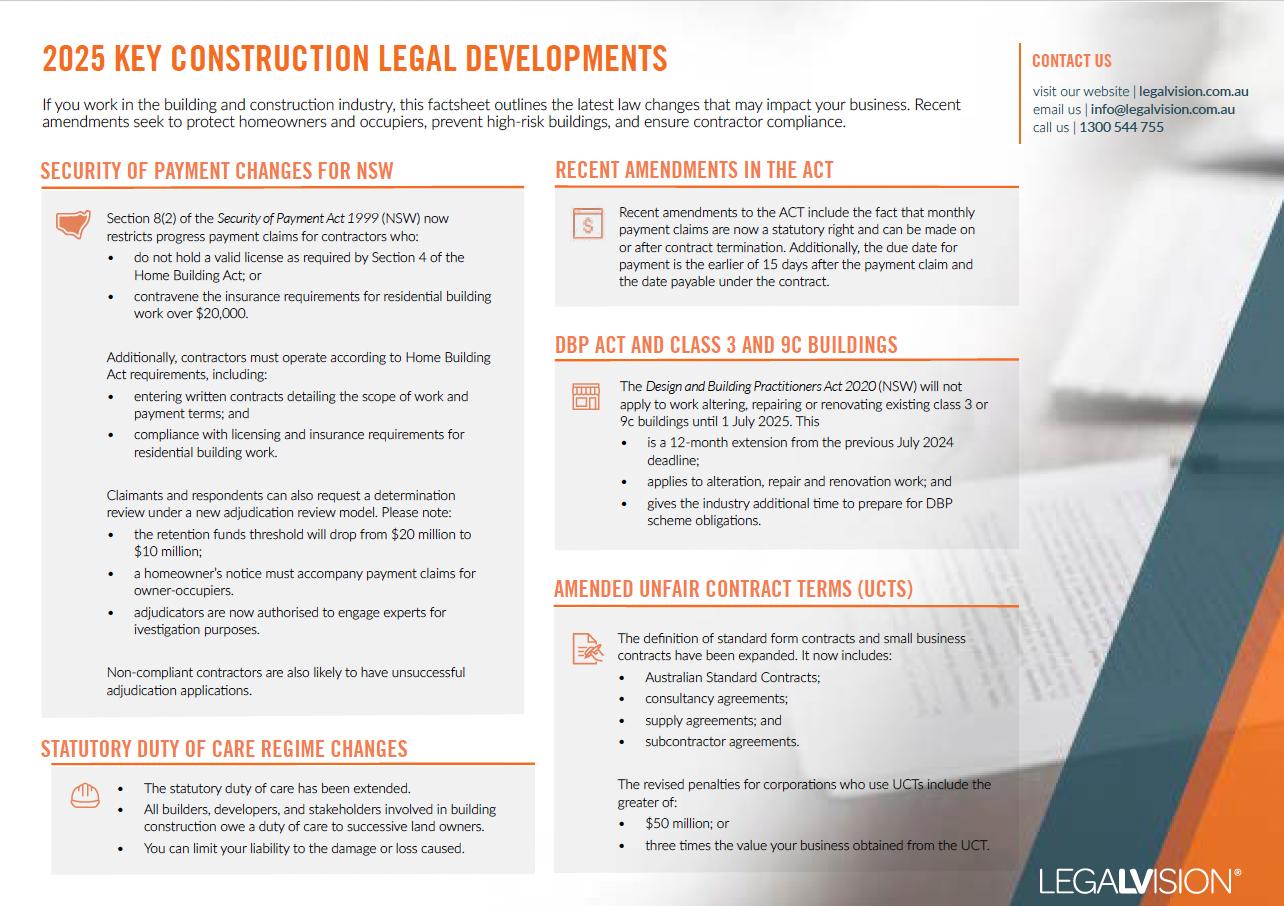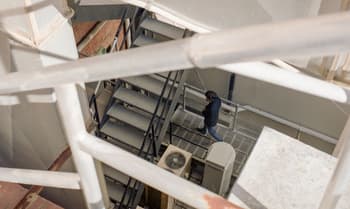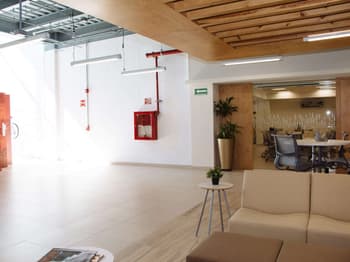In Short
-
Fit-out projects involve renovating internal premises to meet business needs.
-
Obtain landlord consent and necessary local authority approvals before starting.
-
Decide whether to hire a single fit-out company or separate designers and builders, understanding the risks involved.
Tips for Businesses
Get all approvals and landlord consent before beginning fit-outs. Clearly outline contractor responsibilities and use proper contracts to protect your business. Consider hiring a project manager and reviewing your lease for any end-of-lease restoration obligations.
If you are looking to fit-out your office, there are a number of practical and legal considerations that you will need to consider. Even low-cost projects that appear straightforward and simple will come with certain risks. Indeed, you must correctly carry out the process of gaining permissions and engaging contractors to meet your legal obligations. This article outlines the key issues that you need to consider before starting a fit-out project, including strategies you can employ to protect your business’ interests.
What Is a Fit-Out Project?
A fit-out project typically involves renovating or refurbishing the internal premises of your business to suit your needs. This generally involves some kind of construction work that substantially changes the layout of your workspace.
It could also involve refurbishing your office space with the supply of new furniture and fixtures.
This work will usually be carried out by a specialist fit-out contractor. The contractor might perform the renovation project in accordance with:
- their own design; or
- a design prepared by a third-party design consultant, such as an architect.
What Permissions Do I Need?
Before initiating your fit-out project, you will need to think about what approvals and permissions you need to obtain to comply with your legal obligations.
Approval from Authorities
Depending on the type and scale of the fit-out project, you will likely need to gain the approval of specific authorities. Specifically, you may need the consent of your local council to carry out large renovations that could:
- alter the size or appearance of your premises;
- substantially disrupt the area surrounding your premises.
This could also be relevant where you are changing the purpose and use of the premises.
Additionally, you may need to gain other approvals if your premises is a heritage listed building. This is because there may be restrictions on the alterations that you can make to protect the historical value of the original building
Consent From Your Landlord
It is likely that you rent your business premises, which means you need to obtain the consent of your landlord before undertaking a fit-out project. You should check your lease agreement to determine what process is mandated for renovations and refurbishments. It should outline whether:
- fit-out projects are permitted;
- you need your landlord’s consent; and
- there are any restrictions on how you alter the property.

If you work in the building and construction industry, this factsheet outlines the latest law changes that may impact your business.
How Should I Procure the Fit-Out Project?
When planning your fit-out project, it is important that you consider which consultants and building contractors you will need to engage to complete the refurbishments.There are two common ways of procuring a fit-out project, by engaging a:
- design and construction fit-out company; or
- design consultant and then a builder.
1. Engaging a Design and Construction Fit-Out Company
Some contractors will specialise in both the design and construction phases of a fit-out project. These contractors will usually have an internal design team to carry out the design process, including:
- architects; and
- interior designers.
They will also have a construction team, charged with building the works in accordance with the design.
| Pros | Cons |
| There is one single point of responsibility for the fit-out project. This means that you will only need to contact and manage one contractor, as opposed to several. Additionally, you will have a single party to bring a legal claim against if the contractor does not fulfil their obligations under the contract. | The cost of fit out-contractors that undertake both the design and construction of a project is far higher than engaging individual contractors. This is because they are taking on the responsibility and risk of carrying out the entire renovation. |
2. Engaging a Design Consultant and Then Engaging a Builder
Alternatively, you can enter into separate contracts with the design consultants and builders. This would involve taking on the duty of identifying and managing different parties to carry out particular aspects of the project.
You would need to engage a designer to prepare architectural and design drawings, such as an:
- architect;
- engineer; and
- interior designer.
Then, you would need to enter into a building contract with a construction company to build the project, following the designs prepared by your consultants.
| Pros | Cons |
| This option offers you greater flexibility to pick from a broader pool of service providers. Indeed, you can select a specific design consultant and builder to meet your needs, rather than finding a combined service. | There is no single point of responsibility because you have separately engaged two different service providers. If a defect arises in the refurbishments, you will need to prove who was at fault for the defect. The builder might claim that it was a fault in the design, while the designer might argue that the builder failed to construct the work in accordance with their architectural drawings. |
| Engaging individual designers and builders is often cheaper, as one contractor does not need to bear the risk of both phases of the project. | This option makes communication and coordination more difficult. It is important that the designer and builder effectively collaborate throughout the project. This might mean that you need to take a more active role in managing the fit-out project. |
Importantly, it may not always be the case that engaging a separate designer and builder will be cheaper. Similarly, there are ways to mitigate the issues that can arise from having two different points of responsibility if a defect arises. Both of these issues concern which type of contract you choose to use.
What Contracts Should I Use?
Once you have decided which of the two procurement options best suits your needs, you should consider which type of contract to use when engaging:
- consultants; and
- contractors.
This will depend on which of the two procurement options you choose. There will be different contract options according to whether you want to engage a:
- design and construction fit-out contractor; or
- design consultant and then a builder.
I Want to Engage a Design and Construction Fit-Out Contractor
You will need to enter into a contract that covers the fit-out project’s:
- design; and
- construction.
The contractor that you engage may provide you with their chosen form of contract. This may be adequate. However, it is important that you carefully review the provisions. You do not want to make an agreement that unfairly favours the contractor.
Alternatively, you could provide the contractor with your own form of contract. If the value of the fit-out contract is over $1 million, you could use an amended Australian Standards contract. This organisation is recognised as the peak non-government board for standards and has prepared several standardised forms of contract.
If the value of the fit-out contract is less than $1 million, it is recommended that you use a shorter, bespoke fit-out contract.
Depending on the size of the fit-out project, you might also want to engage a project manager to oversee the renovation and manage the relationship with the contractor. You might appoint:
- an internal employee; or
- a third-party project manager.
If you elect for the latter option, you will want to enter into a project management agreement, which sets out the:
- scope of the services that the project manager will provide;
- ability for the project manager to make decisions on your business’s behalf; and
- fee you agree to pay to the project manager.
I Want to Engage a Design Consultant and Then a Builder
You can use a services or consultancy agreement to engage the design consultants. The design consultant may provide you with their chosen form of contract. You should ensure that you closely review this agreement, as it will likely be more favourable to the design consultant. Alternatively, you can propose your own form of service or draft a consultancy agreement with your lawyer.
When engaging the builder, however, you will need to make a choice between a:
- ‘construct only’ contract; and
- ‘design and construction’ contract.
A ‘construct only’ contract is an agreement where the builder is only required to build the works. They are not responsible for the design itself. This means that if any defects arise in the fit-out project, you will need to determine and prove whether it is the fault of the:
- designer for crafting a deficient design; or
- builder for failing to construct the work according to the design.
This can be a difficult task to achieve if it is unclear where the source of the defect originated.
Alternatively, a ‘design and construction’ contract assigns the builder responsibility for both the design and construction of the project. Under this form of agreement, the builder will generally take on the responsibility for the relevant contracts that you entered into with the design consultants. This does not mean that they will carry out the design work. However, they will be legally accountable for any faults that arise.
Minimising Responsibility Under Your Lease
Remember that you will likely need to inform your landlord of the fit-out works to gain their consent. You will also want to eliminate any gaps in your lease and construction agreement, so that you are not held accountable for the actions of your contractor or consultant. This can be achieved by including any relevant obligations in your lease in the contract of your service providers. Passing on this responsibility will ensure that you comply with your lease and minimise any risk that you are exposed to.
Managing Risks in Office Fit-Out Projects
While office fit-outs can significantly improve your workspace, they also come with inherent risks that need to be carefully managed. Here are some key risk areas to consider and strategies to mitigate them.
- Cost Overruns: Fit-out projects can often exceed initial budgets due to unforeseen circumstances or changes in scope. To mitigate this, you should include a contingency fund in your budget (typically 10-15% of the total cost) and regularly review and update your budget throughout the project.
- Cash Flow Management: Ensure you have adequate cash flow to cover project costs, including potential delays. You may have to consider fit-out financing options if necessary.
- Business Disruption: Fit-out works can disrupt your daily operations, and you should plan the continued operation of your business accordingly. If possible, consider temporary relocation to different premises.
- Regulatory Compliance: Ensure your fit-out complies with all relevant building codes, health and safety regulations, and accessibility requirements.
- Contractual Disputes: Ensure your contracts clearly define scope, timelines and dispute resolution processes.
- Health and Safety Risks: Ensure the safety of both construction workers and your employees. This includes verifying that your contractors have appropriate insurance and safety protocols and clearly demarcating construction zones.
By carefully considering and planning for these risks, you can increase the likelihood of a successful office fit-out project that delivers value to your business while minimising potential downsides.
Key Takeaways
You must be wary of your legal obligations when commencing a fit-out project to ensure you comply with your lease and minimise any risk. Before you fit-out your office, you should:
- obtain any required approvals from your local council or your landlord to carry out the project;
- choose whether you want to separately engage design consultants and a builder or a company that offers both design and construction services; and
- ensure that your contracts do not unfairly favour the contractor and ensure that you pass on responsibility for any of your relevant lease obligations to the contractor.
If you have any questions, our experienced construction lawyers can assist as part of our LegalVision membership. For a low monthly fee, you will have unlimited access to lawyers to answer your questions and draft and review your documents. Call us today on 1800 534 315 or visit our membership page.
Frequently Asked Questions
Before beginning, you must get your landlord’s consent and check if local council or building authority approvals are required. Starting work without these can lead to delays, fines, or having to undo the changes. Always confirm requirements early to avoid complications.
Hiring a single fit-out company simplifies communication, as they handle design and construction together. Using separate designers and builders can offer more control, but requires careful coordination to avoid delays or miscommunication. Consider your project size and management capacity before deciding.
We appreciate your feedback – your submission has been successfully received.











